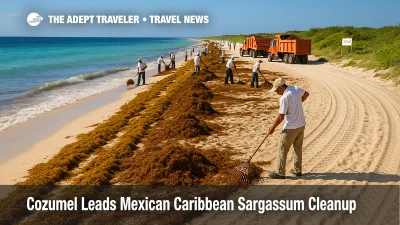Sargassum
When it comes to planning a beach vacation, you want to be sure to pick a location that will provide you with an unforgettable experience. Across the globe, there are a variety of options when it comes to pristine beaches, but one thing you may want to consider prior to booking a trip is the presence of Sargassum.
Sargassum is a type of seaweed found throughout the world’s oceans, especially in shallow coastal regions. It is an incredibly important part of the marine ecosystem and provides habitat to a great deal of marine species, but it can pose some problems for vacationers intent on catching some sun and beachside fun.
Sargassum is a brown algae that can either be free-floating or attached to a substrate. Its thin, ribbon-like blades have a mix of air bladders and sometimes extend to a length of several meters, sometimes forming matted thickets. In most cases the color of the Sargassum ranges between yellowish brown and black. The air bladders help keep the blades afloat, so when breaking waves push the seaweed towards the beach, it can accumulate in piles.
The Gulf of Mexico, Caribbean Sea and the West Atlantic are known for having the largest Sargassum concentrations and can cause problems for many beachgoers. When winds and currents push the seaweed ashore, it creates an aesthetic issue by making the beaches unattractive. This can be particularly discouraging for beachgoers who want to spend a relaxing day in the sun. In addition, Sargassum can also make wading into the ocean difficult, since it tends to be very slimy and can easily wrap around one’s feet.
When a large concentration of Sargassum is pushed ashore, it can also block recreational activities, such as swimming, snorkeling, and simply being able to walk on the beach. Worst of all, the rotting seaweed can produce an unpleasant odor and can create an unbearable environment that is unlikely to be enjoyed by those wanting to enjoy a family day at the beach.
When it comes to Sargassum, timing is everything. Unfortunately, this type of seaweed can’t be constantly monitored for presence, and since the concentration of Sargassum depends on the oceanic and atmospheric currents, predicting its appearance is quite difficult. This means that it’s impossible to tell if a beach will be affected by Sargassum until the waves start coming in.
In some cases, Sargassum can have a severe negative effect on local economies as well. Tourist numbers can drop significantly when Sargassum accumulates near ports, which can cause people to cancel their vacation plans or choose to take their break somewhere else. On top of that, the decomposing seaweed can also lower oxygen levels in the water, making it unsafe for swimming and fish populations.
If you’re traveling to an area with a high risk of Sargassum, it’s important to do some research beforehand in order to be aware of the potential risks. The best time to visit a beach near Sargassum is typically in the winter or spring, since at this time the ocean should be relatively calm with limited wave action. It’s also a good idea to keep an eye on the local Sargassum concentration forecast, so you can be prepared for any potential issues that may arise.
When it comes to selecting the perfect beach locale for your next vacation, the presence of Sargassum should be taken into consideration. While this type of seaweed contributes to a healthy marine ecosystem, it can also cause quite a disruption for those wanting to enjoy a day of sun and sand. Spotting Sargassum in the shallows of the shore is sure to take away from the perfect beach experience, so make sure to do your research and consider a trip to a beach at a seasonally low risk in order to ensure that your vacation is positive and memorable.
Late Season Sargassum Returns to Cancún Beaches

Quintana Roo moves toward first sargassum biogas plant

Cozumel Leads Mexican Caribbean Sargassum Cleanup

Isla Mujeres Clears 2,140 Tons of Sargassum This Season

